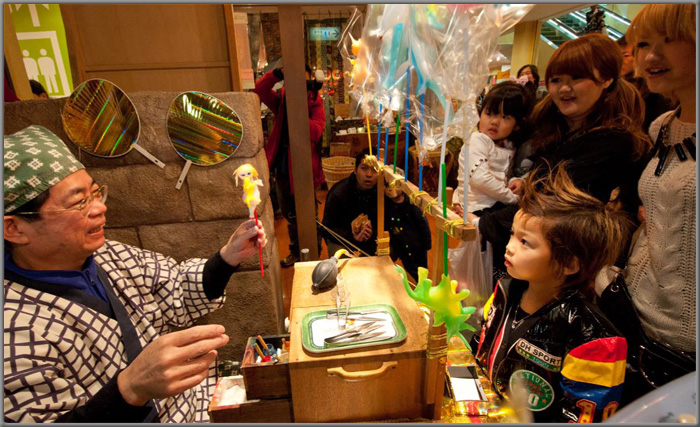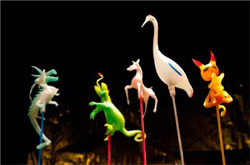Home > Highlighting JAPAN > Highlighting Japan AUGUST 2011 > The Colors of Cool
Highlighting JAPAN
COVER STORY: The Colors of Cool
Caption: Sadaharu Ishiwari at work making amezaiku in Tempozan Market Place. Each piece costs 500 yen, but Ishiwari also gives away bonus candies. As an indication of the size of his repertoire, he can make 100 different types of dogs.
Credit: MASATOSHI SAKAMOTO
The Colors of Cool

Dinosaurs and horses are popular requests in the United States, while in France there are many requests for dragons and cats.
“The best thing about my job is making people happy. That’s the same whether my customers are Japanese or foreigners,” says Ishiwari.
Credit: MASATOSHI SAKAMOTO
The little boy’s request for a three-horned dinosaur is directed at Sadaharu Ishiwari, who reaches into the heated pot beside him and takes out a blob of soft candy about the size of a ping-pong ball, and starts working it with his fingers. After a while, he adds some yellow food dye and kneads it through, so that the transparent candy gradually turns yellow. He makes a cut here with some scissors and tweaks a bit there with his fingers, so that candy stretches, legs and horns appearing as the dinosaur takes shape. Adults and children look on entranced.
“Here you go.”
It’s only been about a minute since he received the request, but there is already a ten-centimeter-long triceratops in Ishiwari’s outstretched hand, and the little boy is grinning from ear to ear.
Ishiwari makes his “candy craft” of amezaiku at a stall in the corner of Tempozan Market Place, a large shopping center next to Osaka harbor, Osaka Prefecture.
Amezaiku is said to have started during the Heian period (794–1192), when it was used to make offerings for temples in Kyoto. Once upon a time, amezaiku stalls could be spotted at festivals all over Japan, but now there are only about twenty professional amezaiku craftsmen in the whole country—and most of these are Ishiwari’s apprentices.
Ishiwari receives a lot of inquiries from overseas. Last year, five people in total from Austria, Australia and the United States came to Japan to spend one or two months learning the craft of amezaiku from Ishiwari.
Ishiwari has also been invited to demonstrate amezaiku at festivals and other events all around the world, including the United States, Australia, Germany, Thailand and Saudi Arabia.
He even did a performance at the Japan Night 2010 side event to the World Economic Forum Annual Meeting (Davos Conference) that was held in Switzerland in January 2010 to introduce the appeal of Japanese foods.
“Amezaiku is a traditional skill; the techniques of the craft have long remained unchanged. The design motifs do however change with the times. Recently, for example, I have received many requests to make candy in the shape of members of the AKB48 pop group,” says Ishiwari. “So, I always have to keep up with the trends.”
In principle, he refuses no request.
There are many similar examples of arts, crafts and fashion products in which Japanese designers and manufacturers draw on unique, long-standing traditions but present their work in contemporary styles. Such products, which are admired around the world, may be considered aspects of “Cool Japan.” This month’s Cover Story introduces some of the people playing a key role in Cool Japan, fusing the traditional with the contemporary.
© 2009 Cabinet Office, Government of Japan






